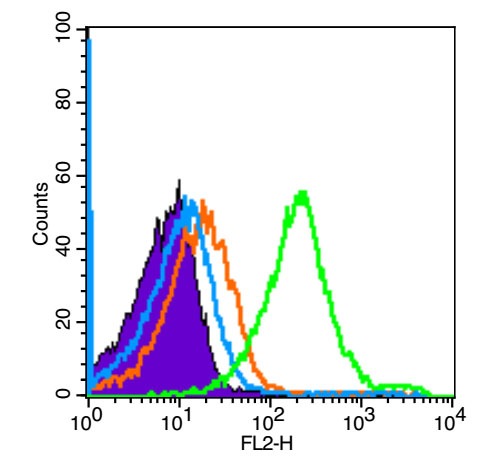购物车
全部删除  您的购物车当前为空
您的购物车当前为空
别名 SMAD2, SMAD family member 2 (SMAD 2;Smad2;hSMAD2), Mothers against DPP homolog 2, Mothers against decapentaplegic homolog 2, Mad-related protein 2 (hMAD-2), MADR2, MADH2, MAD homolog 2, JV18-1
Anti-SMAD2 Polyclonal Antibody 是一种 Rabbit 抗体,靶向 SMAD2。Anti-SMAD2 Polyclonal Antibody 可用于 FCM,IF,IHC-Fr,IHC-P,WB。
Anti-SMAD2 Polyclonal Antibody 是一种 Rabbit 抗体,靶向 SMAD2。Anti-SMAD2 Polyclonal Antibody 可用于 FCM,IF,IHC-Fr,IHC-P,WB。
| 规格 | 价格 | 库存 | 数量 |
|---|---|---|---|
| 50 μL | ¥ 1,160 | 5日内发货 | |
| 100 μL | ¥ 1,960 | 5日内发货 | |
| 200 μL | ¥ 2,790 | 5日内发货 |
| 产品描述 | Anti-SMAD2 Polyclonal Antibody is a Rabbit antibody targeting SMAD2. Anti-SMAD2 Polyclonal Antibody can be used in FCM,IF,IHC-Fr,IHC-P,WB. |
| 别名 | SMAD2, SMAD family member 2 (SMAD 2;Smad2;hSMAD2), Mothers against DPP homolog 2, Mothers against decapentaplegic homolog 2, Mad-related protein 2 (hMAD-2), MADR2, MADH2, MAD homolog 2, JV18-1 |
| Ig Type | IgG |
| 交叉反应 | Human,Mouse,Rat (predicted:Chicken,Dog,Cow,Rabbit) |
| 验证活性 | 1. Sample: Lane 1: Cerebrum (Mouse) Lysate at 40 μg Lane 2: Heart (Mouse) Lysate at 40 μg Lane 3: Testis (Mouse) Lysate at 40 μg Lane 4: Kidney (Mouse) Lysate at 40 μg Lane 5: Placenta (Mouse) Lysate at 40 μg Lane 6: Cerebrum (Rat) Lysate at 40 μg Lane 7: Heart (Rat) Lysate at 40 μg Lane 8: Testis (Rat) Lysate at 40 μg Lane 9: Kidney (Rat) Lysate at 40 μg Lane 10: Hela (Human) Cell Lysate at 30 μg Lane 11: HT1080 (Human) Cell Lysate at 30 μg Lane 12: Jurkat (Human) Cell Lysate at 30 μg Lane 13: Raw264.7 (Mouse) Cell Lysate at 30 μg Lane 14: HL60 (Human) Cell Lysate at 30 μg Primary: Anti-Smad2 (TMAB-01736) at 1/1000 dilution Secondary: IRDye800CW Goat Anti-Rabbit IgG at 1/20000 dilution Predicted band size: 60 kDa Observed band size: 60 kDa 2. Paraformaldehyde-fixed, paraffin embedded (rat brain); Antigen retrieval by boiling in sodium citrate buffer (pH6.0) for 15 min; Block endogenous peroxidase by 3% hydrogen peroxide for 20 min; Blocking buffer (normal goat serum) at 37°C for 30 min; Antibody incubation with (Smad2) Polyclonal Antibody, Unconjugated (TMAB-01736) at 1:200 overnight at 4°C, followed by operating according to SP Kit (Rabbit) instructionsand DAB staining. 3. Blank control (Black line): Mouse spleen (Black). Primary Antibody (green line): Rabbit Anti-Smad2 antibody (TMAB-01736) Dilution: 1 μg/10^6 cells; Isotype Control Antibody (orange line): Rabbit IgG. Secondary Antibody (white blue line): Goat anti-rabbit IgG-PE Dilution: 1 μg/test. Protocol The cells were fixed with 4% PFA (10 min at room temperature) and then permeabilized with 90% ice-cold methanol for 20 min at room temperature. The cells were then incubated in 5% BSA goat serum to block non-specific protein-protein interactions for 15 min at room temperature. Cells stained with Primary Antibody for 30 min at room temperature. The secondary antibody used for 40 min at room temperature.    |
| 应用 | FCMIFIHC-FrIHC-PWB |
| 推荐剂量 | WB: 1:500-2000; IHC-P: 1:100-500; IHC-Fr: 1:100-500; IF: 1:100-500; FCM: 1μg/Test |
| 抗体种类 | Polyclonal |
| 宿主来源 | Rabbit |
| 亚细胞定位 | Cytoplasm. Nucleus. Note=Cytoplasmic and nuclear in the absence of TGF-beta. On TGF-beta stimulation, migrates to the nucleus when complexed with SMAD4. On dephosphorylation by phosphatase PPM1A, released from the SMAD2/SMAD4 complex, and exported out of the nucleus by interaction with RANBP1. |
| 组织特异性 | Expressed at high levels in skeletal muscle, heart and placenta. |
| 构建方式 | Polyclonal Antibody |
| 纯化方式 | Protein A purified |
| 性状 | Liquid |
| 缓冲液 | 0.01M TBS (pH7.4) with 1% BSA, 0.02% Proclin300 and 50% Glycerol. |
| 浓度 | 1 mg/mL |
| 研究背景 | The protein encoded by this gene belongs to the SMAD, a family of proteins similar to the gene products of the Drosophila gene 'mothers against decapentaplegic' (Mad) and the C. elegans gene Sma. SMAD proteins are signal transducers and transcriptional modulators that mediate multiple signaling pathways. This protein mediates the signal of the transforming growth factor (TGF)-beta, and thus regulates multiple cellular processes, such as cell proliferation, apoptosis, and differentiation. This protein is recruited to the TGF-beta receptors through its interaction with the SMAD anchor for receptor activation (SARA) protein. In response to TGF-beta signal, this protein is phosphorylated by the TGF-beta receptors. The phosphorylation induces the dissociation of this protein with SARA and the association with the family member SMAD4. The association with SMAD4 is important for the translocation of this protein into the nucleus, where it binds to target promoters and forms a transcription repressor complex with other cofactors. This protein can also be phosphorylated by activin type 1 receptor kinase, and mediates the signal from the activin. Alternatively spliced transcript variants have been observed for this gene. [provided by RefSeq, May 2012] |
| 免疫原 | KLH conjugated synthetic peptide: human Smad2 |
| 抗原种属 | Human |
| 基因名称 | SMAD2 |
| 基因ID | |
| 蛋白名称 | Mothers against decapentaplegic homolog 2 |
| Uniprot ID | |
| 研究领域 | TGF,SMADs,SMADs,Cytoplasmic |
| 功能 | Receptor-regulated SMAD (R-SMAD) that is an intracellular signal transducer and transcriptional modulator activated by TGF-beta (transforming growth factor) and activin type 1 receptor kinases. Binds the TRE element in the promoter region of many genes that are regulated by TGF-beta and, on formation of the SMAD2/SMAD4 complex, activates transcription. May act as a tumor suppressor in colorectal carcinoma. Positively regulates PDPK1 kinase activity by stimulating its dissociation from the 14-3-3 protein YWHAQ which acts as a negative regulator. |
| 分子量 | Theoretical: 52 kDa. |
| 储存方式 | Store at -20°C or -80°C for 12 months. Avoid repeated freeze-thaw cycles. |
| 运输方式 | Shipping with blue ice. |
评论内容